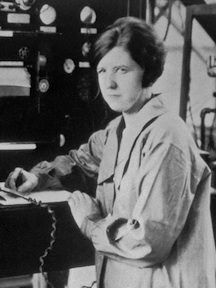By Veena Krishnan
In order for scientists to build upon the knowledge of the past, previous observations must not only be recorded, they must be recorded in a standardized form to ensure effective communication over time. For example, if an experimental protocol calls for reactant A to be added prior to reactant B, but the protocol is not clearly expressed, the reaction could produce a different, potentially unwanted or even dangerous, outcome. As such, the intricacies of language play an integral role in ensuring that scientific accuracy is maintained.
This facet of science—the requirement for organization and standardization in the language and terminology used—is one that pales in comparison to the glamour of making new discoveries. As such, those who record within the sciences are not often acknowledged. Among these unsung heroes of science is Pearl I. Young, the first Chief Technical Editor at the National Advisory Committee for Aeronautics (NACA), predecessor to the National Aeronautics and Space Administration (NASA). Young graduated Phi Beta Kappa from the University of North Dakota in 1919 with a triple major in physics, chemistry, and mathematics. She subsequently took the civil service exam for physicists and in 1921 became the first female physicist to be employed by NACA at the Langley Memorial Aeronautical Laboratory.
Once there, Young was responsible for the instrumentation, specifically calibrating the instruments present on aircrafts. She quickly realized that many of the engineers within NACA did not maintain a standard style when presenting technical reports. This lack of order created difficulties for those who were supposed to analyze and file the reports. Once she noticed the problem, Young bought it to the attention of Harry Reid, the Engineer-in-Charge. Young was then appointed Chief Technical Editor, created a new office that consisted of eight other women, and imposed a variety of guidelines to ensure that the technical reports all maintained a standard style. Despite the initial complaints from the engineers that her style was not efficient and imposed too many demands on their time, she persisted and ultimately became an authority in the field. In 1937, she wrote the Style Manual for Engineering Authors, a series of guidelines that were used to create all the technical reports coming out of NACA. Portions of this manual are still in use today.
This form of standardization helped to create the foundation for the databases that NASA now uses to index and categorize all the technical reports coming out of NASA. The NASA Thesaurus contains the authorized NASA subject terms used to index and retrieve materials in the NASA Technical Report Server (NTRS) and the NTRS Registered. While Young was not directly involved with the creation of the digital version of the Thesaurus, her vision of creating a standardized NASA language for technical reports has led to this incredible resource that allows both the public and scientists alike to understand the nature and magnitude of the work that occurs at NASA.
Young eventually left her position as Chief Technical Editor in 1943 to join the NACA Aircraft Engine Research Laboratory in Cleveland. She trained the technical staff for four years before leaving to teach physics at Pennsylvania State University for ten years. Young eventually returned to the NACA laboratory in Cleveland, where she served as a Technical Literature Analyst until1961. In retirement, Young pursued her interest in aeronautical history and wrote about astronomer Octave Chanute. Her work on Chanute is archived by the Denver Public Library where it is available to the public. Young passed away in 1968. In 2014, the main theater at Langley, the Pearl Young theater, was named in her honor and continues to serve as an important center for meetings at NASA. The following year, she was inducted into the NASA/ NACA Langley Hall of Honor.
When detailing Young’s accomplishments, it is easy and tempting to limit her impact to being a trailblazer for women. While she certainly was a pioneer at NACA, Young’s true legacy lives on in the system of standardized language and style that she created, a system that is still in place today. Her primary contribution to science is that she recognized the need for order in the midst of immense pressure to churn out discovery after discovery. Young ensured that NACA and now NASA continue to maintain the integrity of the scientific process, without sacrificing the process for results.
Veena Krishnan is a junior at Birmingham-Southern College majoring in chemistry and minoring in biology. Birmingham-Southern College is home to the Beta of Alabama Chapter of Phi Beta Kappa.
Photo at top: Pearl I. Young, NASA Langley Research Center, March 29, 1929.




